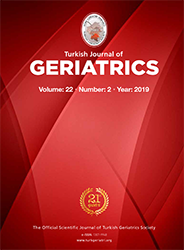2Near East University, Orthopaedics and Traumatology, LefkoĹźa, TRNC DOI : 10.31086/tjgeri.2019.94 Introduction: This study aimed to investigate the associationbetween femoralgeometry and clinical features and to analyse the effect of bisphosphonate use on atypical femur fracture healing.
Materials and Method: Patients admitted with femoral shaft fractures were examined,and thosewhofulfilled the diagnostic criteria for atypical fractures according to the 2014-revised edition of the American Society for Bone and Mineral Research(ASBMR) were included in this study. Fracture localisation, inner and outer cortical thickness, lateral bowing and femur neck-shaft angle of both fractured and contralateral sides were measured. We analysed the correlations between demographics, clinical factors and radiographic features.
Results: Our study group comprised 14 females and 2 males. The mean age was 76.3 (range, 67-91) years. The mean follow-up period was 45.9 (range, 12?84) months. All the fractures were located on the femoral shaft. The mean duration of fracture union was 8 (range, 4-11) months. The outer cortical thickness of the fractured side was significantly greaterthan that of the contralateral side. No significant difference was observed between the inner corticalthickness of the fractured and contralateral sides. The lateral bowing of the fractured femoral shaft was significantly greater than that of the contralateral femur. A significant positive correlation was observed between the duration of bisphosphonate use and both fracture healing time and lateral bowing of the femoral shaft.
Conclusion: Long-term bisphosphonate usealtersthe femoralgeometry not only on the fractured side but also on the contralateral side and increases the fracture risk.
Keywords : Femoral fractures; Osteoporosis; Alendronate; Diphosphonates
